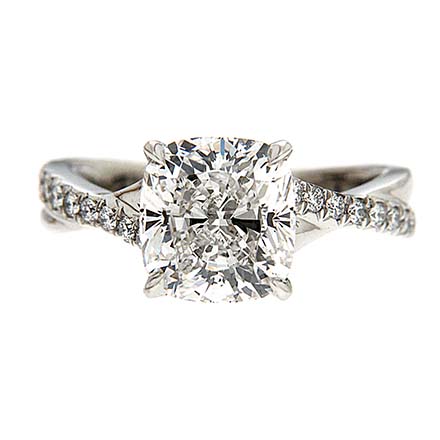Diamonds are known for how they interact with light, which in turn influences qualities such as color, clarity and cut. The many aspects of diamonds with light can make evaluation a challenge. The laboratory must be carefully planned to prevent environmental factors from skewing the results. No one type of light is best for determining all of diamond grading. Gemologists must switch from one type of light to another to fully assess a diamond.
 When examining color, the ideal lighting used should be daylight equivalent fluorescent. This provides neutral illumination that won’t influence the grading process. It also prevents graders from having to depend on the weather and time of day to get consistent light as if they were using actual daylight. Other factors to keep in mind include the diamond being on a neutral colored, nonreflective surface.
When examining color, the ideal lighting used should be daylight equivalent fluorescent. This provides neutral illumination that won’t influence the grading process. It also prevents graders from having to depend on the weather and time of day to get consistent light as if they were using actual daylight. Other factors to keep in mind include the diamond being on a neutral colored, nonreflective surface.
Proper lighting is essential for determining clarity. If a jeweler’s loupe is used to assess the stone, diffused horizontal lighting is recommended. This way, light is evenly distributed and allows for better viewing of the gem’s interior. If using a microscope, it should have darkfield illumination. The technique combines a dark, nonreflective background with lighting that hits the side of the diamond, allowing clarity characteristics to stand out in relief rather than obscured through brilliance or luster.
Certain lights play up reflective qualities, while others suppress it. When evaluating brilliance, it’s best to use lighting that doesn’t interfere with the jewel’s shine, which may lead to an inaccurate grade. Docks with utilize daylight equivalent diffuse lighting are utilized to determine brilliance for consistent results.
For grading fire, several types of light may be used. The preferred kind is light emitting diode (LED) spotlights built into diamond grading docks. If that is not available, penlights or the overhead light from a microscope can be used. The aim is to suppress brilliance and provide a dark background which allows fire to stand out and in turn, simplify grading.
Diamond Surface Modifications
Few gems are perfect. For centuries, people sought to improve their diamonds through how they were mounted. Others directly modified the surface of the diamond to give them the look they wanted. While some unscrupulous vendors may still sell such diamonds today, there are ways to confirm your stone’s quality, such as certification.
In earlier centuries, there was a demand for brilliant diamonds, though cutting techniques couldn’t always accomplish sparkle. Older ways to add brilliance included means such as backing the jewels in foil to increase light return. For those who wanted the look of colored diamonds without the difficulty of finding the rare stones, techniques such as colored foil or other coatings were used.
If a person today decides they want to change the look of their diamonds, surface modifications are still a possibility. However, if someone tries to sell a coated diamond, they must be honest about it. The Federal Trade Commission decrees that any and all changes to a gemstone must be disclosed every time the jewel is sold.
Diamonds certified by the Gemological Institute of America (GIA) are examined to see if any permanent alterations have been performed on the jewel. Surface modifications are considered ephemeral and are not listed in diamond reports. What the certificates will state is the jewel’s actual traits, including carat, color, cut and clarity. People who are unsure of the quality of the diamonds they’re considering can feel free to ask if the diamond is certified by an independent third party laboratory such as GIA.





